A friend of ours told us that the most exciting fishing that he'd had was fishing for Tarpon in Florida, so after another dreary winter at home, Sandy and I decided that this was something we had to do.
We flew from London on a Sunday in April direct to Miami to minimise flying time. It can often pay to go for a longer stay because of the demand for Disneyworld nearby in Orlando. As most families go for one week, by adding a few days, one can sometimes save money. We travelled around the Easter period, so saved over 25% by adding on two days.

We also booked our car hire from the UK and by booking early, it cost just $248 for 10 days, but we always include roadside assistance and additional insurance against damage or theft, having previously had our car broken into. So, after a nine hour flight, we collected the hire car and drove down to Islamorada, half way down the Keys, which took another couple of hours. The Keys are basically islands linked by one road all the way down with minor roads branching off which lead to the beaches. After all the travelling, it was a relief to arrive at John Rawle's house (below) and have the chance to make a cup of tea (very British) and freshen up.

After a night's sleep, I was scheduled for my first trip the following afternoon, fishing for sharks. John accepts parties from the UK built aroud five sessions through the week. This normally consists of three tarpon sessions of about four to five hours each, and two shark sessions in the afternoon of four hours. These programmes are very flexible and can be changed upon request, with extra sessions added, but I found his schedule about right as the fishing can be hard work in the hot afternoon sun.
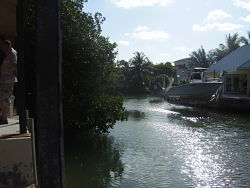
I was paired up on my trips with Mick Toomer from Essex, widely known in the area for the lakes that he ran until recently. At lunchtime on the Monday we headed off from the channel behind the house where all the residents moor their boats. The skiff John owns is designed for inshore fishing with a 150hp outboard capable of some 45 knots. The first thing that strikes you once in the gulf is how clear the water is, especially as it is so shallow. We went about 25 miles out and along the coast and the water was still only about five feet deep with the occasional deeper channel.
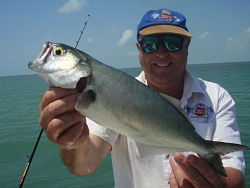
Just prior to reaching our destination we stopped to catch some fish, as the best bait for the sharks is sections of fish. This involved using weighted feathered hooks baited with shrimp fished with a soft rod of about 6' long and a fixed spool reel. My first fish was a bluefish (pictured with John) which fought really hard, as everything did. John told me to careful of its teeth which resemble piranhas'.
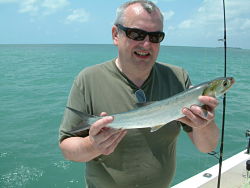
After that I caught three ladyfish which leap around like a tarpon, and a spotted sea trout which was kept for the table. Mick had a similar bag so we then went further out to the edge of a deeper channel where the sharks cruise.
The boat is anchored in position by pushing a pole down into the mud. The chum bag is then put over the side holding all the fish bits left over from other fish previously filleted for the table; nothing goes to waste. The ladyfish are then sectioned and thrown over the stern on shark tackle, 6' rods with a multiplier and a weight to keep the bait and line fixed onto the bottom. I quickly had an abortive run, and when checking the bait found that it had been crushed, probably the result of a large ray, or more likely, a sawfish. Mick was then quickly into a bull shark of about 80lb. These are not to be taken lightly as they will bite humans given the chance. The fish was brought to the side, unhooked and released without leaving the water. Whilst we waited for the next run, we continued to fish for the smaller fish.
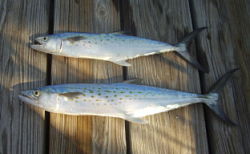
I managed two gray snappers, and a couple of spanish mackerel which were again kept for the table (pictured), another bluefish and a queenfish with sharp spines. Then Mick had his second run and set the hooks into a shark which was obviously much larger than the previous one as it ran the line off the spool. After eventually stopping the first run, the line seemed to be going out so far that it was horizontal. John said I should carry on fishing as Mick would be a while, when a tarpon leapt from the water having taken my bait. I wound down and set the hooks and was into a fight like nothing I've ever experienced. The fish leapt from the water several times and made short powerful runs before I got it to the boat. It was my first (and smallest) tarpon of the week of about 75lb. Again the fish was unhooked at the side of the boat with all eyes watching for sharks which could attack anything splashing around. Under IGFA rules, you are no longer allowed to bring tarpon into the boat, or even remove them from the water so the weight is an estimate from the skipper, but I would have every confidence in their knowledge. John then suprised me and told me to carry on fishing even though Mick was still struggling with his fish.
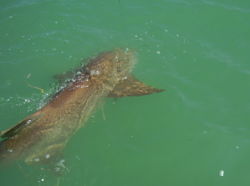
After a short cast, my bait was again taken, this time by a nurse shark (more of a dogfish really) of about 70lbs which quickly came in. They are probably the poorest fighters in the area. The fish was rapidly unhooked and released as Mick was finally making progress with his shark. After a fight of over an hour, the shark was finally pulled alongside the boat and was a big beast, a bull shark of approaching 500lbs. Again, it was unhooked and released being very careful of its teeth.
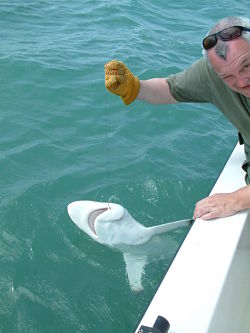
It was then my turn for a run again, and after the previous slow tussle with the nurse shark, this was an altogether different fight dashing around at speed. Several times the line went slack causing me to think that I had lost it before quickly tightening again onto the fish. It was a blacktip shark, one of the better shark fighters well known for their speed. After another extended fight, it was brought alongside and was again around the 80lb mark, but the shark fights simply did not compare with the power, duration or spectacle of the tarpon. That brought the session to a close and we headed back to the house to shower and have a cold drink. I had taken a peaked cap to keep the sun off me, with a detachable flap at the rear to cover your neck, but left it off for a short while at one point. With the sea breeze, it wasn't too hot, but I got badly sunburnt, which was accentuated by my lack of hair! If you fancy this type of fishing in the sun, be more careful than I was because I was badly sunburnt, even in such a short time.
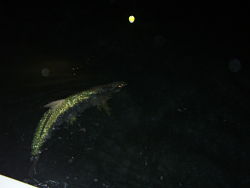
The next sport was a tarpon session scheduled for the following morning at 3 a.m. Tarpon feed best at night, and at the turn of the tide. The water runs from the Atlantic Ocean into the Gulf and vice versa through the gaps between the Keys, linked by road bridges. The fishing here is done by drifting over the likely areas using crabs as bait, The crabs also migrate on the surface, so the hook is pushed through the edge of a protrusion at the side of the crab shell. A float is attached about 5' higher and the tide drifts it away from the side of the boat. The breezes change the boat speed and direction relative to the bait thereby taking the crab away from the boat. At a range of 25 to 30 yards, the bait is checked and the line placed over the forefinger to feel for bites. These may vary from fully blown high power runs to light tugs. Whichever bite you have you must not strike! I was told this but still struck on several occasions from reflex actions. The tarpon's mouth is so hard that this will not set the hook. You have to wind the reel hard pointing the rod at the fish until it becomes too difficult and then try and raise the rod hard which sets the hooks. Even then you will be lucky to hook more than 50%. I had two takes that morning and missed both. The first was a screaming run which I had on for several seconds, watching the fish leap twice well clear of the water before it spat the hook out. Just to show me who was boss it then did a full cartwheel right in front of the boat. The second was a light pluck which I waited to develop (incorrectly) and just got the top shell of the crab back. The tarpon had simply crushed the crab in its mouth and licked the body away leaving just the top shell. As the hook isn't in the crab itselt but clipped in the edge of the shell top there was no possibility of catching the fish or the bite developing, it had simply taken the bait and gone. Mick, who has more experience caught a tarpon of about 70lbs on his first take and then hooked a hard fighting fish. There seems to me to be two types of fight, very hard and unbelievably hard and this fish fell into the latter category. It was hooked about 100 yards from the bridge in the gulf side and after a couple of leaps headed into the gulf before turning and powering through the bridge. John followed in the boat to prevent the line running against the architecture, but the fish just kept going. Mick was playing it as hard as he could but with no effect whatsoever. When the fish appeared to be tiring, it simply rose in the water to the surface, rolled, taking in a gulp of air which reinvigorated it, and off it went again. This lasted for over an hour before John got hold of the leader, but even then the fish didn't like this and simply went off again. Eventually the line gave way as the leader was held momentarily for the fifth time, although this did qualify as caught and the terpon was 170-180lbs. As I turned around, I realised we were probalby about 500 yards from where we had started. This was my first experience of the true strength of the fish which I would not have believed had I not seen it.
As the sun rose, we headed for home for a shower and breakfast.
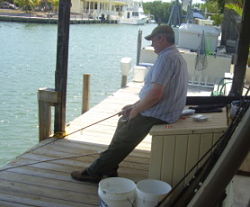
Sandy was enjoying the sunshine with a book, so in the afternoon I decided to fish the channel at the rear of the house. John had told us not to swim in it as it wasn't safe with shark, stingrays and moray eels all present (and we saw them all over the course of the week).
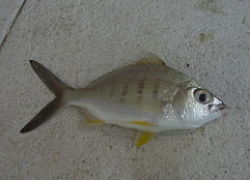
I was happy to fish for small snappers, try for the barracuda which taunted me all week (three times they took my bait and the hook pulled out on every occasion). I started fishing with bread and corn but found that shrimp pieces caught the better sized fish. I caught a range of pretty fish up to 1lb of species yet to be recognised including snapper, porgy, pinfish etc.
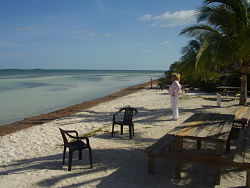
I was scheduled to be tarpon fishing again on the Wednesday morning, but the wind had increased following thunderstorms the previous that evening. This would have made drifting impossible so the session was moved to the Wednesday evening. This gave Sandy and I chance to explore the immediate area. John has access to a private beach for guests on the other side of the road facing the gulf. Here the water is shallow, only knee-deep with white coral sand and palm trees. It really is a superb location and you quickly understand why the Keys are used in James Bond films. We had a pleasant couple of hours walking along the beach paddling in the shallow warm waters of the Gulf.
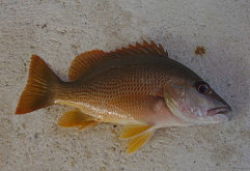
We returned to the house with a couple of hours remaining before the evening tarpon trip, I had time for a few small fish from the rear channel including the snapper pictured here.
At 7 o'clock Jeff, one of John's colleagues, arrived to take Mick and myself out in what for me was to be a truly memorable night. There was still a breeze, but it was much reduced and in the right direction to help drift with the tide.
We started on the ocean side to the bridge, and had no success after the first two drifts, in fact there were no signs of fish at all. Jeff then thought that they must be still be in the gulf, so we sped through the bridge prior to starting our next drift. Jeff had a strong take and after a couple of jumps, the fish shed the hook, which was to be the story of the night. On the next drift, the same thing happened again as both Jeff and I lost fish. 0 fish from 3 takes. After the next 2 drifts we were standing at 0 from 5 showing how hard these fish can be to catch at times. On the next drift I finally managed to catch a fish of around the 80lb mark as our luck started to turn.
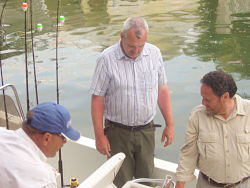
Mick then hooked and lost the next one, and I managed to catch my best fish of the week, one of 130lb which put up a good fight, then Jeff caught one making 3 from 9 which is a fair ratio with a novice such as myself on board. One the next drift I had another take and foolishly struck - missing it completely. Then Mick lost another before I hit into the hardest fighting fish that I have ever hooked.
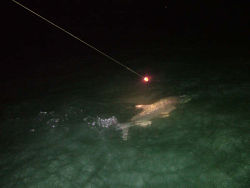
After a couple of jumps the fish steadied down for a long fight. On the first steady run it took all the line from the spool and we had to follow in the boat ,which gave me a chance to regain line. Once a satisfactory position had been achieved, off it ran again, not quite so far this time but we still had to chase it in the boat. I then managed to hold it as it circled the boat taking runs at regular intervals, occasionally coming up for gulp of air. Finally, as it circled the boat for the umpteenth time I shouted for Jeff to grab the leader because I was totally spent - and it was only 125lb!
We went around for another drift but I was praying that I wouldn't hook another one that evening because I had no strength left. I was even aching the next morning when I got up, these fish are unbelievable.
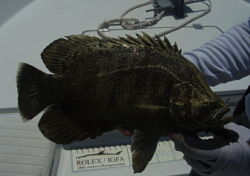
Sandy and I decided to go out the following morning but were unable to start the car. Although I'd shuffled the cars around earlier without any problem, it refused to start. A quick call to the hire company and we had a replacement which took about three hours to get to us. By this time, we were nearly due for our next trip, an afternoon session with Kip. This was meant to be a shark session but we decided to try for other species. I really enjoy the variety of fishing and seeing all the different fish. As we had done previously, we stopped for baitfish.
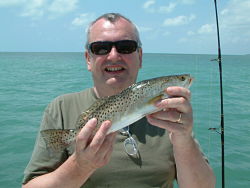
I caught a couple of the speckled sea trout, three ladyfish and a gafftopsail catfish which was immediately returned. These are not popular fish because of the spines and are unhooked and returned without handling. Mick had a similar catch including a good sized speckled sea trout so we then headed off to one of Kip's special marks. On the way, we were shown how one species, a tripletail (pictured) is found around buoys and similar marks on the surface. We decided to have a try and caught one each by overcasting with a shrimp and drawing t back past the fish. You know when it has spotted the bait because it drifts from the mark, at which point you slow the retrieve and wait for a tug. After a brief pause you tighten on the fish and set the hooks. These have a reputation for being excellent to eat but must be 15" to qualify. Mine was only 14.5" and was duly returned.
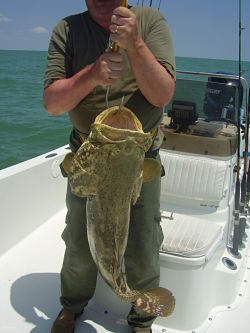
After 15 minutes of fun fishing, we moved on to our main destination. This is also an area where we may encounter goliath grouper, the largest member of the family which grow to extraordinary size, and Mick caught one of around 60lb on his first cast. They are big fish with the most enormous mouths and fight well. Just my luck to catch a nurse shark on my first take, although it was another of around the 75-80lb mark. Mick then caught another grouper, although about 30lb this time before I caught my first of 30-35lb (pictured). Although many would be appalled to see a gaff used, it merely penetrates the skin behind the jaw and does no lasting damage that a net or dragging the fish into the boat to unhook it would do and all the fish were returned in pristine condition. Mick then had another of similar size before my next run which proved to be a shark which simply bit through the leader. Mick had another grouper before the sport stopped, just as if someone had thrown a switch.
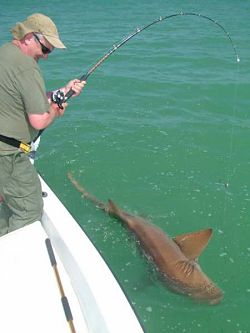
We then moved to the next mark where I caught a nurse shark of 120-130lb before we had a really unusual experience. Mick had been getting gentle taps on his line before my reel screamed as a fish headed off. I set the hooks and started to play the fish to the left. It then swung around to the right of the boat and I ducked under Mick's line to try to eliminate any snagging, but as I wound the fish in, it became clear that the two lines were entwined. When the tangle came to the surface, Kip tried to unravel it to prevent the fish being lost, but wasn't able to and the line parted. As we wound in, my bait came straight in and Mick's line was snapped; the fish had been on his rod all the time but he had been given no indication, whereas I had managed to play the fish on my rod - really strange!

It was then time to head home, still puzzled and tell a chilled-out Sandy of our adventures.
In the evening we had a barbecue at the back of the house with the main course being the fish we had caught, but also with prawns, crab claws, lobster freshly caught from just up the road. There were eight of us in total as John accommodates three groups of up to three anglers each week, assisted by very capable local skippers where more than one session needs to be run at any time.
Being fishermen, we couldn't resist putting a rod out in the channel which had been prebaited with the fish bits that we didn't need. Darren (with his father Eddie pictured below) from Bletchley had a take on a pilchard float-legered and was into a fish which slowly ran down the channel to the sea which he managed to turn and bring to the surface; it was a nurse shark of 20-25lbs. Unfortunately, Darren had used a commercial wire trace which failed as we drew the fish to the bank, although he did manage a small catfish later on.
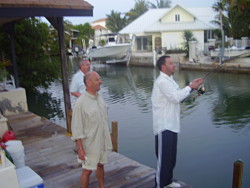
On the Friday, we did some shopping prior to the evening session, finding a well stocked supermarket about 5 miles up the road, next to the larget tackle shop that I have ever seen, Worldwide Angler, which I am told is part of the Bass Pro group. It was on the scale of a UK department store with sports clothing, rods, lures etc etc, including a restaurant upstairs. It is not to be missed unless you are on a tight budget, in which case don't go in!
My final session ended in failure, but was still fascinating. The wind was higher than normal and a bit troublesome for John, but I had a good run and fight before the tarpon eventually spat the hook out. As we hadn't quite reached the end of the drift, I rebaited and started to let the crab drift from the baot which was immediately smashed by another tarpon. I had the bail arm open and the rod tucked under my elbow in a very casual manner and had been caught totally unprepared. I forced the bail arm over and tried to set the hooks, but with the butt of the rod not secured in my midriff, I had no power and after a couple of spectacular leaps this fish threw the hooks too. Beaten twice in a couple of minutes!!! Mick also had one throw the hooks after a couple of minutes fight before the area went quiet so we moved to another position. Sport was slow here but Mick managed to set the hooks firmly into a fish which leapt five times before starting to take line and run around the boat. Because of the light tide and wind direction, John had been forced to anchor the baot in this location. The fish swam around 180 degrees under the anchor rope and launched itself into the air over the rope, tying the line around the rope and disappearing into the sunset leaving Mick with smashed line.
I managed another light take which I struck (I know I shouldn't have but 40 years of habit is hard to break) and didn't set the hook and lost the fish. That proved to be the last take in the main sessions of the week.
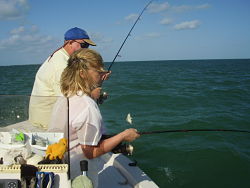
Sandy is terrified of being in a boat on the sea, so I asked John if he could arrange a two hour trip for the pair of us just a short way out so that Sandy could catch a fish. She was reluctant at first as she suffers from sea sickness, but I assured her that as the water is generally only 3' deep; there is no swell which is normally the cause of the problem, and that the small waves wouldn't affect her. Although scared, she agreed to try and so John took us out the next morning - and Sandy's knees were knocking. He found an area where the fish would be feeding, highlighted by murky water colouration caused by the invertebrates digging, which the fish descend upon. We both caught a couple of blue runners and a lizardfish apiece. These are curious fish with the head being exactly like a lizard, including a huge gaping mouth which seems to extend up and down and sideways. I also had a catfish and a gray snapper before we decided to call it day.
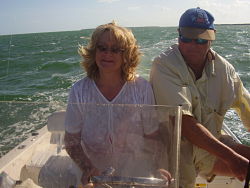
John said we should take the boat up some of the channels where manatee can often be seen and told Sandy to drive the boat. What a transformation! From being terrified of water, she was now driving the boat and we got to see a manatee too, well its head and tail anyway, as it rolled and they are huge creatures. We stopped to fill the boat with fuel and bought some crab claws, prawns and lobster for a final night's barbecue before heading back to the house, driven by Sandy who is still smiling a week later as I write this.
Mick Toomer said as we headed out on one of our excursions, that we were actually doing what most people only read or dream about, but you CAN do it too. If you fancy this fantastic fishing, you might like to contact our guide John Rawle on
bellropes@btinternet.com I would highly recomend you go with him as he is one of the foremost guides in the area. Without local knowledge you would lose out on many of the experiences detailed in the diary entry, and the whole trip is, in my view, not to be missed.